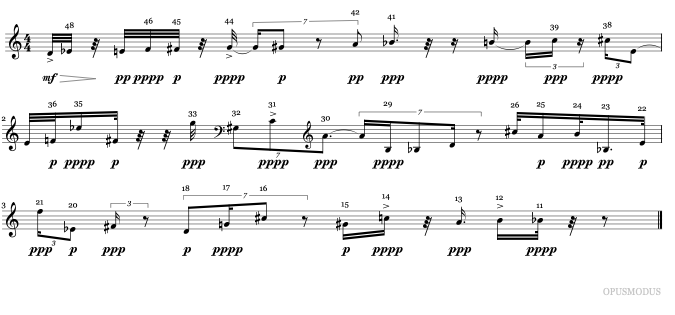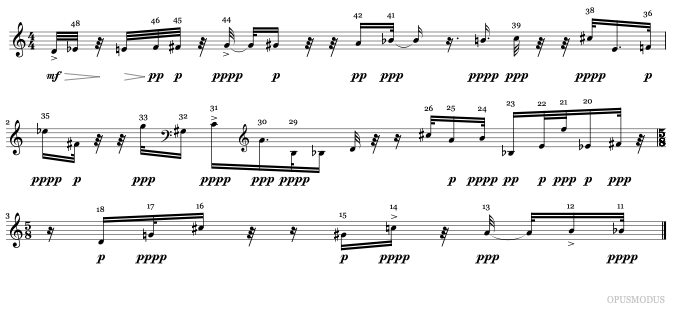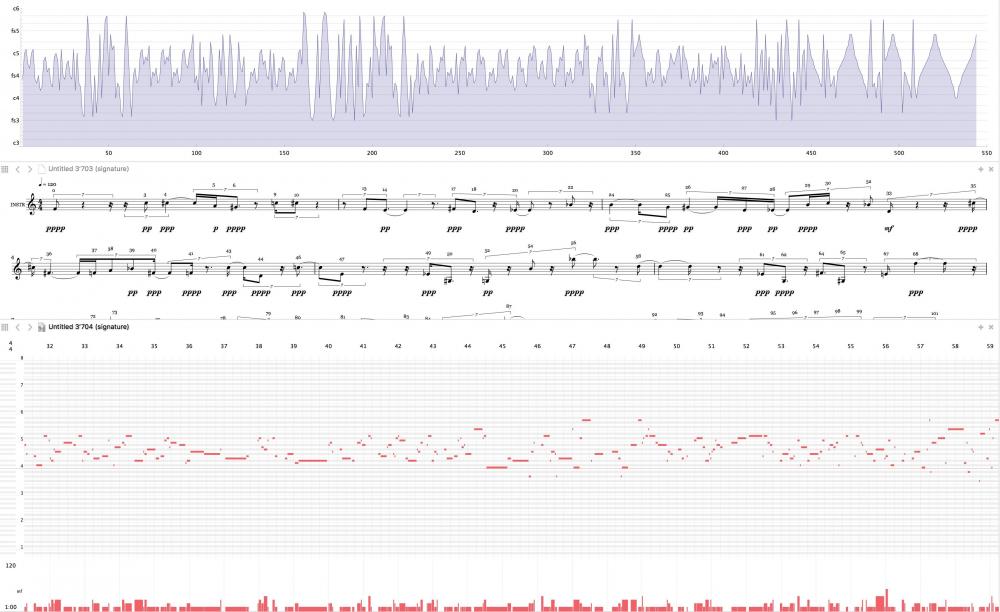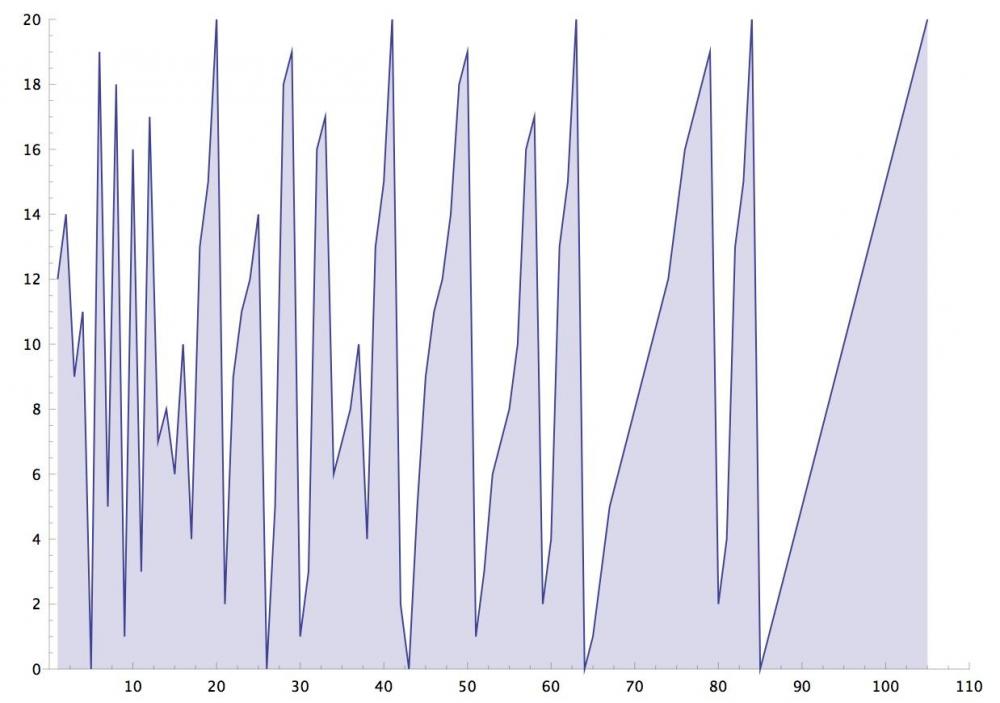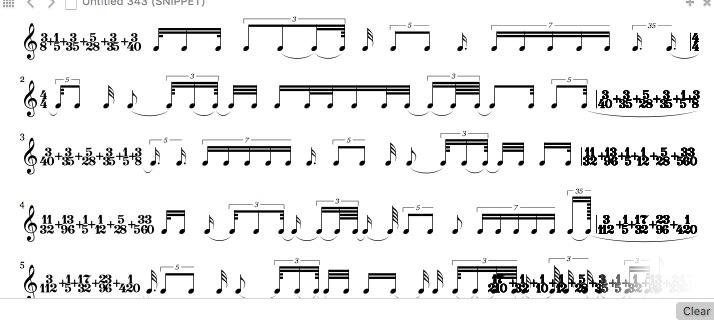-
Posts
805 -
Joined
-
Last visited
Content Type
Forums
Events
Store
Video Gallery
Everything posted by AM
-
dear all is there a possibility to change the PAN in every EVENT? 1) like '((q c4 mp pan-30) (e c3 pp pan100)) would be interesting for LIVE-CODING is there something predifined? like it will come up with microtonality/tuning 2) and why does it work with simple-midi-sound (a list in :pan) and not with a player like conTimbre (there is something i don't understand with midi/players/etc)? thanx for a hint andré an example: (setf omn '((5q c4 5q 5q 5q 5q 5q 5q 5q) (-q) (e e e e e) (-q) (7q 7q) (3q 3q) (-q) (5q 5q 5q) (7q 7q) (3q 3q 3q 3q) (e e) (-q) (3q 3q 3q 3q 3q) (e e e e e))) ;;; (def-score signature (:title "signature" :key-signature 'atonal :time-signature '(4 4) :tempo 60) (instr ;:port 0 :omn (omn-replace :velocity (pick-norepeat 100 '(pppp ppppp ppp ppp pp p)) (length-diminution 4 (gen-repeat 10 omn))) :tuning (gen-white-noise 100 :scale 0.1) :pan '(1 1 1 1 1 1 1 1 10 30 1 1 1 100 100 80 77 15 100 100 100) :channel 1 :sound 'gm-trumpet))
-
I got a trial version of the new conTimbre-player-maxpatch (from thomas hummel), now the opusmodus-tuning also works well in conTimbre. I think it will be in the next update ... ...i like it more in cents then in float... (defun cents-to-tuning (centlist) (a*x 0.01 centlist)) (cents-to-tuning '(-14 +50 5)) => (-0.14 0.5 0.049999997)
- 5 replies
-
- microtonality
- contimbre
-
(and 1 more)
Tagged with:
-

Parsimonious Voice Leading (again): attempts to provide an algorithm
AM replied to JulioHerrlein's topic in Function Examples
(ambitus-octaves 'c3 2 (closest-path '(b3eb5g3 cs6e7gs3 b4f5g6 f7e5c2 d4f7e4 gs7e2a8))) => (g3b3eb4 gs3cs4e4 b3g3f4 c4f3e4 d4e4f3 e4gs3a3) or you could put this two FUNCTIONS into ONE => (closest-path*... just take all the values/arguments from the basic version and add the octave-thing? greetings andré- 23 replies
-
- voice-leading
- parsimonious voice leading
-
(and 1 more)
Tagged with:
-
i already did that (defun add-rnd-dust (omnseq &key (span '(0.1)) (seed nil) (quantize '(1 2 3 4 5 6 7 8 9)) (scale 1.0) (tolerance 0.05)) (let ((rhy (omn :length omnseq)) (sp)) (progn (setf rhy (loop with cnt = 0 for i in rhy do (setf sp (nth cnt span)) when (not (null seed)) do (incf seed) when (> i 0) collect (+ i (car (rnd-number 1 0.0 (* i sp) :seed seed))) else collect (- i (car (rnd-number 1 0.0 (* i sp) :seed seed))) when (< cnt (1- (length span))) do (incf cnt))) (make-omn :length (quantize (float-to-ratio rhy :ratio 1/1) quantize :scale scale :tolerance tolerance) :pitch (omn :pitch omnseq) :velocity (omn :velocity omnseq) :articulation (omn :articulation omnseq)))))
-
an example: this is the BASIC-version (without "dust"): all mapped in 1/32 - retrograde sorting processes (with GEN-SORT): pitch-process from chromatic to 12tone-row (by sort) and from sorted length-values (all 1/32, then all 1/16 etc... to more complex/mixed pattern (by sort)) with this setup: the result with some "dust": if you you have a look to the span-list above (compare with the new score) you will see: no change at the beginning, then more and more randomized (or made flexible).
-
@janusz: if you try the function a few times (without seed) , you will see (by cmd1), that sometimes the last TIE isn't there. i think QUANTIZE is doing this little bug... (but perhaps only a xml-display-thing?)
-
;;; ADD-RND-DUST TO LENGTHS ;;; this function adding RANDOMLY some "dust" to the LENGTHS, so it will be like a little rubato, ;;; or "humanizing"-effect. the ADD-SPAN is in percent (0.1 = 10%) on each length-value. (defun add-rnd-dust (omnseq &key (span '(0.1)) (seed nil) (quantize '(1 2 3 4 5 6 7 8 9))) (let ((rhy (omn :length omnseq)) (sp)) (progn (setf rhy (loop with cnt = 0 for i in rhy do (setf sp (nth cnt span)) when (not (null seed)) do (incf seed) when (> i 0) collect (+ i (car (rnd-number 1 0.0 (* i sp) :seed seed))) else collect (- i (car (rnd-number 1 0.0 (* i sp) :seed seed))) when (< cnt (1- (length span))) do (incf cnt))) (make-omn :length (quantize (float-to-ratio rhy :ratio 1/1) quantize) :pitch (omn :pitch omnseq) :velocity (omn :velocity omnseq) :articulation (omn :articulation omnseq))))) ;;; EXAMPLE (add-rnd-dust '(h c3 h. d3 -h q. f3 q g3) :span '(0.5 0.3 0.2 0.1) :quantize '(1 2 3 4 8) :seed 123) => (ht c3 h.s. d3 -e -q -t e.._3h f3 3q_q g3) (add-rnd-dust '(q c3 q d3 q e3 q f3 q g3) ;;possible add-span per value (1 = 100% of the value, 0.5 = 50% etc.) ;;if it's a list, it will stay on the last value of the span-list :span '(0.4 0.3 0 0 2) ;;how to quantize new lengths :quantize '(1 2 4 8) :seed 123) => (q c3 qt d3 q e3 f3 hs. g3) (add-rnd-dust '(h c3 h. d3 h e3 q. f3 q g3) :span '(0.5) ;; = every value max-add 50% :quantize '(1 2 3 4 8) :seed 2999) => (hs. c3 wt d3 3w.e e3 3wq. f3 q g3) (add-rnd-dust '(q c3 q d3 q e3 q f3 q g3) :span '(0.4 0.3 0 0 2) :quantize '(1 2 4 8) :seed 1111) => (qt c3 qs d3 q e3 f3 q... g3) (add-rnd-dust '(h c3 h d3 h e3 h f3 h g3) :span '(0.3 0.2 0.1 0 0.2) :quantize '(1 2 4 3 5) :seed 2999) => (5dh. c3 5dhq. d3 h e3 f3 he g3)
-
the only problem seems to be, that it only works with CCL 1.12 on mojave... but this is not the official actual version in apple's appstore. so it don't work with 1.11.... does anyone know how to fix this problem?
-
dear all does anyone have experience with an implementation of LISP in maxmsp? i'm looking for: "Max handling real time input, output, timing and control, letting Lisp handle variable handling and of course the processing of large amounts of data" Cycling '74 CYCLING74.COM Tools for sound, graphics, and interactivity does anyone tested this? thealexgraham/lisper GITHUB.COM Lisper is an easy to use interface between Max/MSP and Common Lisp - thealexgraham/lisper thanx for a hint andré
-
"My focus is on the ever-changing relationship that composers have with rules and procedures." some ideas/names...? => MOZART https://en.wikipedia.org/wiki/Musikalisches_Würfelspiel => the LIGETI-analysis of BOULEZ's STRUCTURES ? => MESSIAEN in general: https://monoskop.org/File:Messiaen_Olivier_The_Technique_of_My_Musical_Language.pdf, or specific "MODE DE VALEURS ET D'INTENSITÉS" => GOTTFRIED MICHAEL KöNIG => XENAKIS (the "ST"-pieces?) => HAUER https://de.wikipedia.org/wiki/Zwölftonspiel
-
i took the old one - it worked well
-
i know, LOOPS are not very LISPian! but for me the most simple way "to think such processes" (more intuitive then recursion/iteration). and when the function/code is not to large it's not that important...
-
(loop for i in (gen-divide 2 '(c 4 d 5 e 3 c 6 eb 4)) collect (compress i)) => (c4 d5 e3 c6 eb4) i didn't read you posts precisely. only the last ONE ...but you could use COMPRESS...?
-
have fun... greetings andré ;;; here is a MULTI-GEN-SORT ------------------------- ;;; you could interlace different processes of SORTING (defun multi-gen-sort (lists &key (types nil) (sorts '>) (steps nil) (seed nil)) (let* ((sorted-lists (loop for i in lists for cnt = 0 then (incf cnt) collect (gen-sort i :type (if (listp types) (nth cnt types) types) :sort (if (listp sorts) (nth cnt sorts) sorts) :step (if (listp steps) (nth cnt steps) steps) :seed seed)))) (flatten (loop repeat (find-max (loop for i in sorted-lists collect (length i))) for cnt = 0 then (incf cnt) collect (loop for i in (reverse sorted-lists) collect (nth cnt i)))))) ;;; some examples (pitch-list-plot (flatten (multi-gen-sort (list (expand-tonality '(c5 'chromatic)) (expand-tonality '(c3 'chromatic)) (expand-tonality '(c4 'chromatic)) (expand-tonality '(c6 'chromatic))) :types '(selection insertion min-max selection) :sorts '(> > > >) :steps '(7 6 7 3))) :join-points t :point-radius 0 :style :fill) (pitch-list-plot (flatten (multi-gen-sort (list (rnd-order (expand-tonality '(c5 'chromatic))) (rnd-order (expand-tonality '(c3 'chromatic))) (rnd-order (expand-tonality '(c6 'chromatic))) (rnd-order (expand-tonality '(c4 'chromatic)))) :types '(insertion selection min-max selection) :sorts '(> < < >) :steps '(5 3 7 nil))) :join-points t :point-radius 0 :style :fill) (pitch-list-plot (flatten (multi-gen-sort (list (rnd-order (expand-tonality '(c6 'chromatic))) (rnd-order (expand-tonality '(c5 'chromatic))) (rnd-order (expand-tonality '(c4 'chromatic))) (rnd-order (expand-tonality '(c3 'chromatic)))) :types '(selection nil insertion min-max) :sorts '(< > < >) :steps '(4 4 4 4))) :join-points t :point-radius 0 :style :fill) (pitch-list-plot (filter-repeat 1 (flatten (multi-gen-sort (list (rnd-order (expand-tonality '(c4 'chromatic))) (rnd-order (expand-tonality '(cs4 'chromatic))) (rnd-order (expand-tonality '(d4 'chromatic))) (rnd-order (expand-tonality '(ds4 'chromatic)))) :types '(insertion selection min-max selection) :sorts '(> < > <) :steps '(5 5 5 5)))) :join-points t :point-radius 0 :style :fill) ;;; a SORT2 :-) (pitch-list-plot (flatten (gen-sort (flatten (multi-gen-sort (list (rnd-order (expand-tonality '(c6 'chromatic))) (rnd-order (expand-tonality '(c5 'chromatic))) (rnd-order (expand-tonality '(c4 'chromatic))) (rnd-order (expand-tonality '(c3 'chromatic)))) :types '(selection nil insertion min-max) :sorts '(< > > >) :steps '(3 3 3 3))) :type 'insertion :step 7 :sort '>)) :join-points t :point-radius 0 :style :fill) some examples: a sorted mulit-gen-sort:
-
you should also share your ideas/thoughts/concepts!!??
-
hi julio it's too complicated to share the code...the FUNCTION is made for a specific idea of the work (not common), so it's made for MY need... here is a short sketch of the work... (part of it) a) generating a pitch-sequence => by using a 12-tone-seq + its expansion by a sorting-algorithm (with GEN-SORT) => an INTERVAL-order mutates to a SCALE (see the list-plot) b) pitches are projected on a sequence of symmetrical expanding/compressing FIELDS (with CHORD-CONTR...) => you see how the pitch-seq is contracted/exapnded in "space" - result is a kind of interference of this processes => at the end you see (in list-plot) that the interference is going more and more to ONE LEVEL - to a SCALE - so its a kind of inside/out. the inherent structure, the inherent process/order is more and more recognizable during the process (start with compr/exp. 12-tone-row to the simple SCALE) the project is a bit larger. this sequence (which rhythm is based on a binary-event-filter (data of a jpeg of an artist)) is only the structural background (some ideas developed by LACHENMANN) - on this NET (the score you see) there will be other GESTALTS/MOTIFS etc... because my needs are such specific to my and my idea - most of the functions i had to code for myself, or modify/enlarge the OPMO functions, great that this is possible on this platform. sorry a bit complicated and i can't not describe it properly with a few words
-
BUG is fixed now. should work correct!
-
;;; THIS FUNCTION DOING SYMM TRANSPOSITIONS TO CONRACT (OR EXPAND, depends on INTERVAL) A CHORD or PITCH-SEQ ;;; default setting: it changes in every generation the highest and lowest pitch by an OCTAVE ;;; by changing :position (see examples) you could change which position should be changed/transposed ;;; default interval is 12 ;;; FUNCTION (defun chord-contraction/expansion (n pitchlist &key (position nil) (interval 12) (chord nil)) (let* ((pitchlist (if (chordp (car pitchlist)) (melodize pitchlist) pitchlist)) (position (if (null position) (list 0 (1- (length pitchlist))) (if (listp position) position (list position (- (1- (length pitchlist)) position))))) (pitchlist (cons pitchlist (loop repeat n collect (setf pitchlist (sort-asc (flatten (position-replace position (list (pitch-transpose interval (list (nth (car position) pitchlist))) (pitch-transpose (neg! interval) (list (nth (cadr position) pitchlist)))) pitchlist)))))))) (if (null chord) pitchlist (chordize pitchlist)))) ;;; EXAMPLES: evaluate by cmd3 (setf 12-tone-field '(f3 fs3 gs3 c4 d4 e4 b4 cs5 eb5 g5 a5 bb5)) (chord-contraction/expansion 4 12-tone-field :chord t) => ((f3fs3gs3c4d4e4b4cs5eb5g5a5bb5) (fs3gs3c4d4e4f4bb4b4cs5eb5g5a5) (gs3c4d4e4f4fs4a4bb4b4cs5eb5g5) (c4d4e4f4fs4g4gs4a4bb4b4cs5eb5) (d4eb4e4f4fs4g4gs4a4bb4b4c5cs5)) (chord-contraction/expansion 4 12-tone-field :chord t :interval 48) => ((f3fs3gs3c4d4e4b4cs5eb5g5a5bb5) (bb1fs3gs3c4d4e4b4cs5eb5g5a5f7) (f3fs3gs3c4d4e4b4cs5eb5g5a5bb5) (bb1fs3gs3c4d4e4b4cs5eb5g5a5f7) (f3fs3gs3c4d4e4b4cs5eb5g5a5bb5)) ;;; with spezific positions (inner change) (chord-contraction/expansion 4 12-tone-field :chord t :position 3) => ((f3fs3gs3c4d4e4b4cs5eb5g5a5bb5) (f3fs3gs3d4eb4e4b4c5cs5g5a5bb5) (f3fs3gs3cs4eb4e4b4c5d5g5a5bb5) (f3fs3gs3d4eb4e4b4c5cs5g5a5bb5) (f3fs3gs3cs4eb4e4b4c5d5g5a5bb5)) (chord-contraction/expansion 4 12-tone-field :chord t :position '(0 5)) => ((f3fs3gs3c4d4e4b4cs5eb5g5a5bb5) (e3fs3gs3c4d4f4b4cs5eb5g5a5bb5) (f3fs3gs3c4d4e4b4cs5eb5g5a5bb5) (e3fs3gs3c4d4f4b4cs5eb5g5a5bb5) (f3fs3gs3c4d4e4b4cs5eb5g5a5bb5)) ;;;; with different intervals (chord-contraction/expansion 4 12-tone-field :chord t :interval 11) => ((f3fs3gs3c4d4e4b4cs5eb5g5a5bb5) (fs3gs3c4d4e4e4b4b4cs5eb5g5a5) (gs3c4d4e4e4f4bb4b4b4cs5eb5g5) (c4d4e4e4f4g4gs4bb4b4b4cs5eb5) (d4e4e4e4f4g4gs4bb4b4b4b4cs5)) (chord-contraction/expansion 4 12-tone-field :chord t :interval 7) => ((f3fs3gs3c4d4e4b4cs5eb5g5a5bb5) (fs3gs3c4c4d4e4b4cs5eb5eb5g5a5) (gs3c4c4cs4d4e4b4cs5d5eb5eb5g5) (c4c4cs4d4eb4e4b4c5cs5d5eb5eb5) (c4cs4d4eb4e4g4gs4b4c5cs5d5eb5))
-
often helpful in PATTERN MATCH things... (like in OPMO pattern-match-functions) here is a short IDEA for an octave-independent PITCH-PATTERN-MATCHP with possible WILDCARD, perhaps could help you... ;;;-------------------------------------------------------------- ;;; PITCH PATTERN-MATCHP octave-independent ;;;-------------------------------------------------------------- ;;; SUB (defun convert-pitch (pitches) (loop for i in pitches when (pitchp i) collect (compress (butlast (explode i))) else collect i)) ;;; MAIN (defun pitch-pattern-matchp (pitchlist pattern) (let ((pitchlist (convert-pitch pitchlist)) (pattern (convert-pitch pattern))) (pattern-matchp pitchlist pattern))) (pitch-pattern-matchp '(c4 d4 eb4 f4 g4) '(c ? e)) => nil (pitch-pattern-matchp '(c4 d4 eb4 f4 g4) '(c ? eb)) => t
-
a kind of MERGE-SORT -> sorry for bad coding i didn't find a better solution -> perhaps a new SORT for GEN-SORT... (defun kind-of-merge-sort (alist) (progn (setf alist (mcflatten (loop repeat 30 do (setf alist (loop for i in (gen-divide 2 alist) collect (sort-asc (flatten i)))) collect alist))) (loop repeat (length alist) for cnt = 0 then (incf cnt) when (not (equal (nth cnt alist) (nth (1+ cnt) alist))) collect (nth cnt alist)))) (list-plot (flatten (kind-of-merge-sort (rnd-order (gen-integer 0 20)))) :join-points t :point-radius 0 :style :fill)
-
thanx stephane! ...but when you have a look on the output... (gen-retrograde durations1 :omn t) => ((t s t) (t 13/96 3q) (5h = 3/35 7q = = = = 3/35 5h =) (3q 13/96 t) (t s t)) or with FLATTEN: (gen-retrograde (flatten durations1) :omn t) => (t s t 3q 13/96 t 5h = 3/35 7q = = = = 3/35 5h = t 13/96 3q t s t) the "original notation" with no troubles => ((t s t) (3q 3e_s. t) (5h 5h 5q_7q 7q 7q 7q 7q 7q 7q_5q 5h 5h) (t s._3e 3q) (t s t))
-
for some score-display it would be very very useful if when EVAL etc... (or use any of the OPMO-functions) OMN-notation would be displayed and not changing to RATIOS... have a look to this example: it's written like that, because then the display is very smart. when i use "rnd-pick" or other functions it changes from OMN to RATIO... very ugly then. is there an internal solution for that or another trick? thanx for help a. ;; NICE DISPLAY BY CMD3 (setf durations1 (list '(t s t) '(3q 3e_s. t) '(5h 5h 5q_7q 7q 7q 7q 7q 7q 7q_5q 5h 5h) '(t s._3e 3q) '(t s t) )) => ((t s t) (3q 3e_s. t) (5h 5h 5q_7q 7q 7q 7q 7q 7q 7q_5q 5h 5h) (t s._3e 3q) (t s t)) ;;; UGLY DISPLAY BY CMD3 because of the OPMO-fuction (gen-retrograde durations1) ;; should result the same rhythm => ((1/32 1/16 1/32) (1/32 13/96 1/12) (1/10 1/10 3/35 1/28 1/28 1/28 1/28 1/28 3/35 1/10 1/10) (1/12 13/96 1/32) (1/32 1/16 1/32)) ;;; the same (rnd-pick durations1) => (1/32 13/96 1/12) ;;; OKAY because LISP and not OPMO (nth 0 durations1) => (t s t) a practical example: ;;; WORKS => because in the last step it's on LISP-level (setf durations (list '(t s t) '(3q 3e_s. t) '(5h 5h 5q_7q 7q 7q 7q 7q 7q 7q_5q 5h 5h) '(t s._3e 3q) '(t s t) '(t t t t) '(5q 5q 5q 5q 5q) '(3q 3q 3q) '(7q 7q 7q 7q 7q 7q 7q))) (setf morph-list (flatten (gen-morph 7 '(0 1 2 3) '(4 5 6 7)))) ;;cmd3 (setf newdurations (loop for i in morph-list append (nth i durations))) ;;; DON'T WORK => because OMPO chanhig the format to RATIOS (setf durations1 (list '(t s t) '(3q 3e_s. t) '(5h 5h 5q_7q 7q 7q 7q 7q 7q 7q_5q 5h 5h) '(t s._3e 3q) '(t s t))) (setf durations2 (list '(t t t t) '(5q 5q 5q 5q 5q) '(3q 3q 3q) '(7q 7q 7q 7q 7q 7q 7q))) ;;cmd3 (setf newdurations (flatten (gen-morph 7 durations1 durations2)))
-
with BAR and BEAT? that's great JANUSZ, you are always two steps ahead or "MILES AHEAD" (trumpeter's joke :-)) but WHEN will be the RELEASE?
-
thanx for the span-ignore-pause-HINT! ...but it makes no sense to me - when you are working with EVENTS (by numbering it) - to ignore some of them the idea behind this concept is, that you could work with a (finished) score by changing some parameters or enlarge rests - like a kind of "post-production". in this way it's not necessary to go deep inside you generating-algorithms, you can only change things a little bit like in a notation-software (i think it's on that level). some months ago i had the idea to do such changes (post...) by positions with BARS/BEATS - but at the moment i think it's much better to signify the EVENTS and work directly on them. less errors and easy to code such post...-functions.
-
to use the function which works on event-numbers, first you have to number it (the score), so that you could work with this afterwards... ;;; ADD numbers to text attributes (can do that in your setup), then ADD number to events ;;; have a look to the example. after that, easy to use REPLACE-ON-EVENT-NUMBER etc... (defun add-numbers-to-text-attributes (a b) (loop for i from a to b append (add-text-attributes (list (compress (list 'nr i)) (write-to-string i))))) (add-numbers-to-text-attributes 0 100) (defun add-num-to-events (omnlist) (loop for x in (single-events omnlist) for i from 0 to (length (single-events omnlist)) when (omn-formp x) collect (omn-replace :articulation (list (compress (list 'nr i))) x) else collect x)) ;;; evaluate cmd3 (setf seq (add-num-to-events '(-q q c4 mp -q -q e e e e e q c4 mp -q -q q c4 mp -q))) => ((-q) (q c4 mp nr1) (-q) (-q) (e c4 mp nr4) (e c4 mp nr5) (e c4 mp nr6) (e c4 mp nr7) (e c4 mp nr8) (q c4 mp nr9) (-q) (-q) (q c4 mp nr12) (-q))



